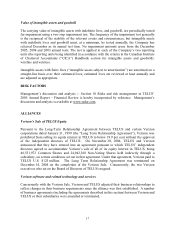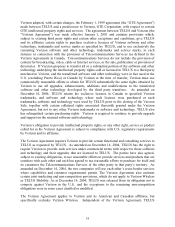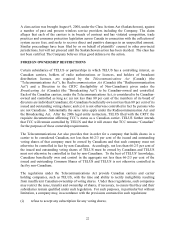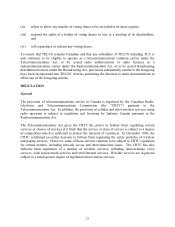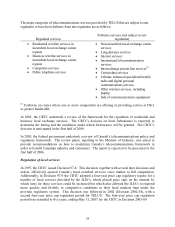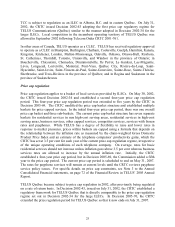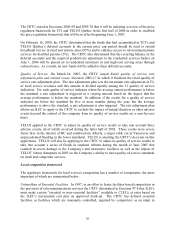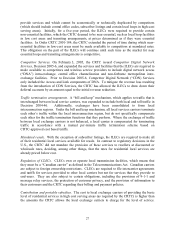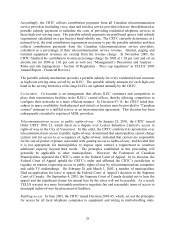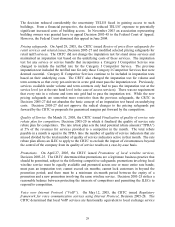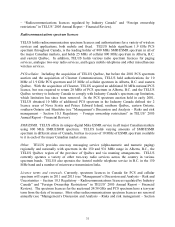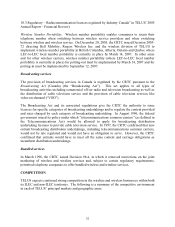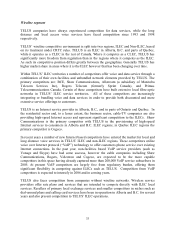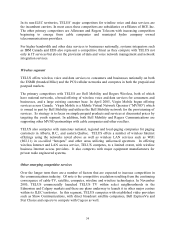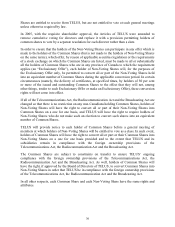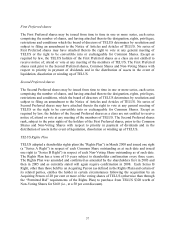Telus 2005 Annual Report Download - page 28
Download and view the complete annual report
Please find page 28 of the 2005 Telus annual report below. You can navigate through the pages in the report by either clicking on the pages listed below, or by using the keyword search tool below to find specific information within the annual report. 27
provide services and which cannot be economically or technically duplicated by competitors
(which should include central office codes, subscriber listings and certain local loops in high-cost
serving areas). Initially, for a five-year period, the ILECs were required to provide certain
non-essential facilities, which the CRTC deemed to be near essential, such as local loop facilities
in low cost areas and transiting arrangements, at prices determined as if they were essential
facilities. In Order CRTC 2001-184, the CRTC extended the period of time during which near-
essential facilities in low-cost areas must be made available to competitors at mandated rates.
This obligation on the part of the ILECs will continue until such time as the market for near
essential loops and transiting arrangements is competitive.
Competitor Services. On February 3, 2005, the CRTC issued Competitor Digital Network
Services, Decision 2005-6, and expanded the services and facilities that the ILECs are required to
make available to competitors and wireless service providers to include digital network access
(“DNA”) intra-exchange, central office channelization and non-forborne metropolitan inter-
exchange facilities. Prior to Decision 2005-6, Competitor Digital Network (“CDN) Services
only included the Access and Link components of DNA. To mitigate the revenue loss resulting
from the introduction of CDN Services, the CRTC has allowed the ILECs to draw down their
deferral accounts by an amount equal to the initial revenue reduction.
Traffic termination arrangements. A “bill and keep” mechanism, which applies to traffic that is
interchanged between local service carriers, was expanded to include both local and toll traffic in
Decision 2004-46. Additionally, exchanges have been consolidated to form local
interconnection regions. Under the bill and keep mechanism, all local services carriers terminate
each other’s traffic within the local interconnection region, but do not specifically compensate
each other for the traffic termination functions that they perform. Where the exchange of traffic
between local exchange carriers is not balanced, a local carrier is compensated for terminating
traffic in accordance with a mutual per-minute traffic termination scheme based on
CRTC-approved cost based tariffs.
Mandated resale. With the exception of subscriber listings, the ILECs are required to make all
of their residential local services available for resale. In contrast to regulatory decisions in the
U.S., the CRTC did not mandate the provision of these services to resellers at discounted or
wholesale rates, deciding, among other things, that the rates for residential local services are
already priced below cost.
Regulation of CLECs. CLECs own or operate local transmission facilities, which means that
they must be a “Canadian carrier” as defined in the Telecommunications Act. Canadian carriers
are subject to foreign ownership restrictions. CLECs are required to file intercarrier agreements
and tariffs for services provided to other local carriers but not for services that they provide to
end-users. They are also subject to certain obligations, including the provision of 9-1-1 and
message relay services, the protection of customer privacy, and the provision of information to
their customers and the CRTC regarding their billing and payment policies.
Contribution and portable subsidies. The cost to local exchange carriers of providing the basic
level of residential services in high cost serving areas (as required by the CRTC) is higher than
the amounts the CRTC allows the local exchange carriers to charge for the level of service.


